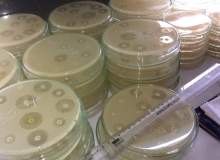

In May 2016, British economist Lord Jim O’Neill, chairman of the UK’s Review on Antimicrobial Resistance (AMR), published the group’s final report and recommendations for combating the rising threat of AMR around the world. The report, which was more than two years in the making, lays out the incredible costs of disease-causing bacteria becoming increasingly resistant to antibiotics and other antimicrobial agents – 10 million lives could be lost to resistant bugs every year by 2050, the report warns, and the cumulative global financial cost of this growing health crisis could reach $100tn by the end of the century.
The review’s final report represents a calamitous diagnosis for the world’s health in the coming decades, and its recommendations press for urgent, multilateral action to avoid the unthinkable – slipping back to an age before antibiotics, when common infections could once more prove fatal. The effects on global health are serious even now.
"The medicine cabinet is empty for some patients," said US Centers for Disease Control director Dr Tom Frieden in May. "It is the end of the road unless we act urgently."
For Chris Del Mar, professor of public health at Bond University on Australia’s Gold Coast and co-ordinating editor of the Cochrane Acute Respiratory Infections Group (Cochrane ARI Group), the key achievement of the report is making clear the devastating consequences of AMR and the heroic collective effort that will be required to avert disaster.
See Also:
"Perhaps the most important thing is the report nails the seriousness of all this to the mast," he says. "Not just to health, but the economic consequences, which will all be catastrophic. Some of the recommendations are radical – it’s not just the recommendations that are important, but the fact that we must face radical change. No longer can we be complacent with business-as-usual."
How well do you really know your competitors?
Access the most comprehensive Company Profiles on the market, powered by GlobalData. Save hours of research. Gain competitive edge.

Thank you!
Your download email will arrive shortly
Not ready to buy yet? Download a free sample
We are confident about the unique quality of our Company Profiles. However, we want you to make the most beneficial decision for your business, so we offer a free sample that you can download by submitting the below form
By GlobalDataThe call for new rapid diagnostics
A break from business-as-usual is indeed the core recommendation from the O’Neill report, as it has become known. The review lays out ten areas on which to focus in the global campaign against AMR, including a worldwide public awareness campaign, improving the pipeline of new antibiotics in development and creating appropriate financial mechanisms to fund the innovation that will be needed.
Developing a new wave of effective antimicrobial agents is vital, but a key aspect of tackling AMR in a sustainable way is the need to drastically reduce the unnecessary use of antibiotics so that the march of resistance is slowed and life-saving last-resort drugs remain effective for longer.
Cutting the excessive use of antibiotics in agriculture is an important pillar of this effort, but in terms of human health systems, the large-scale prescribing of antibiotics for illnesses that probably don’t even require their use is the major problem to be overcome. The solution recommended by the O’Neill report is to speed up the development and adoption of cutting-edge rapid diagnostic tests that can help prescribers in hospitals and primary care to distinguish when antibiotics are actually needed.
This is a healthcare area that has remained virtually static for decades, with doctors using their expertise to judge the necessity of antibiotics using empirical observations, and sometimes using lab-based tests to subsequently confirm or change the prescription. The report makes a bold call for progress.
"Doctors in most countries around the world still prescribe important medicines like antibiotics based only on their immediate assessment of a patient’s symptoms, just like when antibiotics first entered common use in the 1950s," the review argues. "Governments of the richest countries should mandate now that, by 2020, all antibiotic prescriptions will need to be informed by up-to-date surveillance and a rapid diagnostic test, wherever one exists."
The need for point-of-care tests that work
"Wherever one exists" is the operative phrase here – as the report notes, tests of this type are irregularly used even in advanced healthcare systems, and the tests that are administered are predominantly lab-based processes that take 36 hours or more to culture the bacteria and confirm the type of infection and the drugs to which it is susceptible. This is a problem for general practitioners, who need to make prescription decisions quickly, often faced with the tricky dilemma of whether to prescribe antibiotics for common respiratory infections, the majority of which are caused by viral rather than bacterial infection, making antibiotics useless.
Del Mar notes that more research needs to be done to get more insight on the spread of resistance through human health systems through over-prescription, but due to the sheer volume of prescribing, primary care is likely to be playing a significant part in the growth of AMR.
"It’s hard to tell," he responds when asked about the role of primary prescribing in AMR. "The research that tracks whether resistance tracks across from primary care into hospitals hasn’t been done yet. But it is likely it does – primary care is where 80% of antibiotics are prescribed."
So the need for faster tests that can be used at the point of care is acute. But there are a host of technical challenges that need to be overcome before rapid bacterial testing can become a reality for general practitioners, as noted by a study forecasting the availability of tests by Ann Van den Bruel and Philip Turner of Oxford University’s Diagnostic Evidence Cooperative, one of the many subsidiary studies carried out under the O’Neill report’s banner.
Tried and true: what are the options for point-of-care testing?
Molecular diagnostic tests, which identify microorganisms – or ‘biomarkers’ present in a sample’s genetic material that can give information on known mechanisms of resistance, may be useful in some circumstances, but they have a limitation in that the presence of biomarkers that suggest resistance may not result in actual phenotypic resistance. This means that positive results from molecular testing could actually increase unnecessary antibiotic prescription because, as Van den Bruel and Turner note, "the identification of resistance markers in the absence of phenotypic resistance markers would present prescribing quandaries to clinicians".
Phenotypic resistance tests, meanwhile, offer a more comprehensive diagnostic result because they identify drug resistance regardless of genotype, but the interpretation of these tests is often subjective and dependent on the judgement of the operator, making them currently less useful as a tool for primary care or users in the field who aren’t specialists.
Research is underway by many organisations and laboratories to develop new, innovative tests, but speed is proving to be a problem. Researchers at Duke University recently reported on the progress on a simple blood test that can separate bacterial and viral infections by scanning a patient’s genetic reaction to the invading microbe. However, current technology means the test takes ten hours; the team is working to speed up the process to an hour, but even this would be longer than the ten minutes that has been highlighted as an optimal waiting time for primary care users.
Without dramatically faster and more accurate testing methods, these tools seem doomed to be too clunky to make the required impact on unnecessary antibiotic prescriptions. A November 2014 review of evidence by the Cochrane ARI Group found that the use of bio-markers for point-of-care testing at present could bring some reduction in antibiotic use, but the extent of the improvement is unknown. This uncertainty might mean that, for now, more traditional methods might be more effective.
"I agree with the radical need to do something, but I am not sure [point-of-care testing] is the best approach," says Del Mar. "The research on using diagnostic tests to guide diagnosis shows it reduces antibiotic use a bit, but not hugely. Rather I think the solution is likely to be ‘shared decision making’, where doctors explain the benefits and harms of antibiotic use – not as much benefit, and more harm, than most folk believe."
Getting new tests into the hands of prescribers
For the future, however, more advanced point-of-care tests should form an important part of anti-AMR efforts in responsible health systems. According to Van den Bruel and Turner’s analysis, at the current rate of progress, "technologies which are currently in relative infancy will form the diagnostics base in 10-15 years hence, unless measures are taken to expedite this process."
So how can the development and implementation of fast, accurate, user-friendly tests be sped up? As with most problems in a free market global economy, the answer is more money. Individual incentives such as the UK’s Longitude Prize are a good start, but there is a need for a more sustained flow of financial assistance for the research and roll-out of new tests that would be a public benefit.
The O’Neill Report recommends that a portion of its proposed Global Innovation Fund for AMR should be dedicated towards supporting early research in the area of diagnostics. For developing countries where affordability and access are problematic, the report suggests a Diagnostic Market Stimulus that will provide subsidy top-up payments for AMR-relevant diagnostic purchased, operating in a similar way to the Gavi public/private vaccine alliance’s top-up mechanism that has, in the report’s words, "revolutionised global vaccine coverage".
Financial support doesn’t end with simply pumping more money into research and procurement; O’Neill’s recommendation that advanced economies mandate testing for all antibiotic prescriptions whenever possible would help incentivise development and commercialisation in the pharma industry as it would provide assurance to developers that there is a receptive target for products that could cost billions to bring to market.
Beyond all the scientific and financial challenges involved in filling the current technology gap for rapid diagnostic testing, the core problem at present is that it’s simply cheaper in the short term – both in terms of cost and time – for doctors to prescribe antibiotics excessively than to make sure that the prescription is useful and necessary. In the long-term, this ugly truth will no longer be acceptable. In the field of testing and all other approaches to the resistance crisis, there will need to be a sea change in the global perspective on AMR, and a renewed commitment to tackling this threat that outstrips anything that has come before. Anything less will leave patients perilously exposed to an unfolding public health disaster that has the potential to dominate the 21st century.




